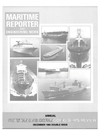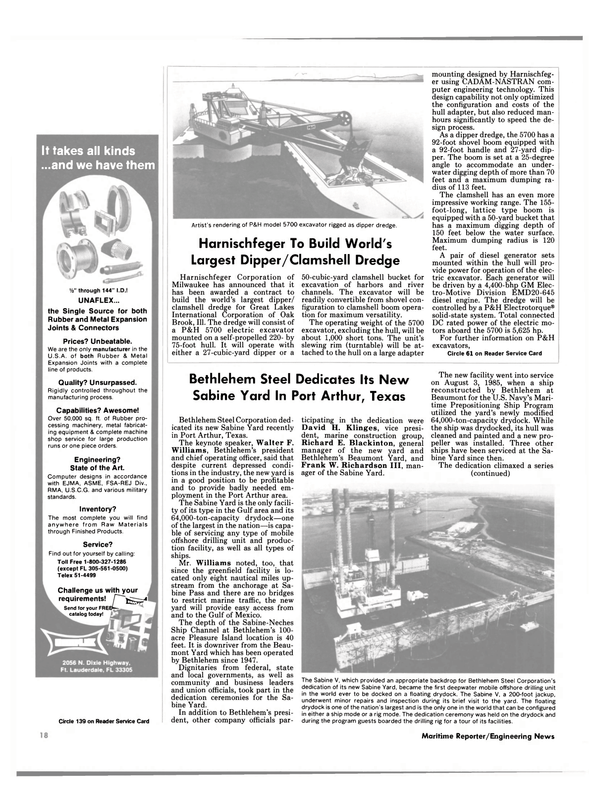
Bethlehem Steel Dedicates Its New Sabine Yard In Port Arthur, Texas
Bethlehem Steel Corporation dedicated its new Sabine Yard recently in Port Arthur, Texas.
The keynote speaker, Walter F.
Williams, Bethlehem's president and chief operating officer, said that despite current depressed conditions in the industry, the new yard is in a good position to be profitable and to provide badly needed employment in the Port Arthur area.
The Sabine Yard is the only facility of its type in the Gulf area and its 64,000-ton-capacity drydock—one of the largest in the nation—is capable of servicing any type of mobile offshore drilling unit and production facility, as well as all types of ships.
Mr. Williams noted, too, that since the greenfield facility is located only eight nautical miles upstream from the anchorage at Sabine Pass and there are no bridges to restrict marine traffic, the new yard will provide easy access from and to the Gulf of Mexico.
The depth of the Sabine-Neches Ship Channel at Bethlehem's 100- acre Pleasure Island location is 40 feet. It is downriver from the Beaumont Yard which has been operated by Bethlehem since 1947.
Dignitaries from federal, state and local governments, as well as community and business leaders and union officials, took part in the dedication ceremonies for the Sabine Yard.
In addition to Bethlehem's president, other company officials participating in the dedication were David H. Klinges, vice president, marine construction group, Richard E. Blackinton, general manager of the new yard and Bethlehem's Beaumont Yard, and Frank W. Richardson I I I , manager of the Sabine Yard.
The new facility went into service on August 3, 1985, when a ship reconstructed by Bethlehem at Beaumont for the U.S. Navy's Maritime Prepositioning Ship Program utilized the yard's newly modified 64,000-ton-capacity drydock. While the ship was drydocked, its hull was cleaned and painted and a new propeller was installed. Three other ships have been serviced at the Sabine Yard since then.
The dedication climaxed a series of events which got underway more than a year before. In the interim Bethlehem had acquired use of the U.S. Navy surplus drydock—a selfsustained floating shipyard—constructed ancillary facilities for the drydock and dredged a portion of the ship channel to a depth of 60 feet to accommodate the drydock.
Also, Bethlehem built office and equipment repair facilities and relocated two miles of a state highway which ran through the Sabine Yard property.
The drydock had been berthed in Hawaii for more than 40 years when it was towed earlier this year to the Beaumont Yard for modification and reactivation work—a 14,000- mile journey.
After several months at Beaumont, the sections were towed to the Sabine Yard and assembled into the ship configuration mode in mid- July.
For oil rigs, the sections can be arranged in two side-by-side batteries.
This configuration provides a clear docking area of 414 feet by 362 feet. To accommodate drillships or other types of vessels, such as the four ships drydocked during the summer and early fall, the sections were lined up in tandem for a clear docking area of 829 feet by 122 feet.
Lease and operational documents between Bethlehem and the City of Port Arthur, owner of the Pleasure Island property, and the Port of Port Arthur, owner of the drydock, were signed in November 1984.
Ownership of the drydock was transferred from the U.S. General Services Administration to the State of Texas to the Port of Port Arthur. The port allows Bethlehem to use it through an operating agreement approved by the federal agency and the port authority.
For further information on Bethlehem Steel, Circle 69 on Reader Service Card
Read Bethlehem Steel Dedicates Its New Sabine Yard In Port Arthur, Texas in Pdf, Flash or Html5 edition of December 1985 Maritime Reporter
Other stories from December 1985 issue
Content
- United States Cruises Applies To M a r A d For $150-Million Title XI page: 4
- PA Series Heavy Fuel Diesel Now Available From Fairbanks Morse page: 6
- Six-Page Color Brochure On Energol Lubricants Offered Free By BP Marine page: 6
- Getty Fleet Orders Lips Speed-Adapted Propellers To Increase Efficiency page: 6
- Karl Senner Offers Free Color Brochure On Reintjes Marine Gearboxes page: 6
- OMSA Elects New Officers —Congressman Warns Of California Plan' page: 8
- Birka Line Cruise Ship Launched At Valmet's Helsinki Shipyard page: 8
- Fire Combat, Inc. Offers 10-Page Manual On Fire Suppression Systems page: 9
- Texaco Appoints Quegan General Manager, Marine Department page: 10
- Fernstrom Elected President And CEO Of American Ship Building page: 10
- New Briefcase Computer For Marine Industry From NAV-COM page: 12
- Furuno USA Introduces New Doppler Speed Log And ARPA Line page: 12
- W. Anthony Watt Heads Sales And Marketing Division At Moran Towing page: 14
- Marinette Delivers First Of Ten Torpedo Weapons Retrievers page: 14
- Bassett Named President Of Interocean Management page: 14
- Kockums To Build Ferry With First Coal-Fired Marine Steam Engines In 30 Years page: 16
- COSCO And McMullen Form New Company— COSCO North America page: 17
- Cunard Gives $115-Million Contract To Lloyd Werft To Convert QE2 To Diesel And Alter Accommodations page: 17
- Harnischfeger To Build World's Largest Dipper/Clamshell Dredge page: 18
- Bethlehem Steel Dedicates Its New Sabine Yard In Port Arthur, Texas page: 18
- Totem To Acquire Controlling Interest In Interocean Steamship Corp. page: 20
- OUTSTANDING OCEANGOING SHIPS OF 1985 page: 22
- NOTABLE CONVERSIONS OF 1985 page: 44
- Bender Shipbuilding Wins $4.5 Million In Contracts page: 49
- Construction of 'Theodore Roosevelt' Ahead Of Schedule And Under Budget page: 50
- Magnavox Introduces New Generation SatCom And New GPS/Transit SatNav Receivers page: 51
- GPS/Transit SatNav Receivers page: 52
- Network 90, Integrated Marine Management System For Reduced Costs And Maximized Profits page: 55
- SHIPBOARD COMPUTER SURVEY page: 58
- Ellicott Machine Corporation Announces Personnel Changes page: 68
- Vapor Corporation Announces New Sphere Matrix Technology page: 68
- U.S. NAVY SHIP PROCUREMENT Second Quarterly Update—November 1985 page: 70
- MSI Conducting Tests For Proposed Canadian Ferry With Voith Schneider Propulsion page: 77
- Design Improvements In EMD's 645FB Diesel Provide Higher Horsepower, Better Fuel Economy page: 78
- Perko Presents The 200 Series International Navigation Lights page: 81
- Coast Guard Completes Installation Of Advanced Navigational Aid In N.Y. Harbor page: 85
- Macmeter Offers Metering Protection page: 91
- MARDATA Named North American Agent For Lloyd's Information Services page: 91


